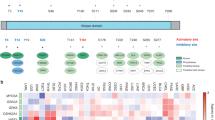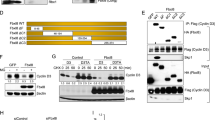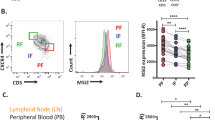Abstract
Three D-type cyclins, cyclin D1, D2 and D3, belong to the G1 cyclin, which regulates the G1/S transition of the cell cycle, and feature highly homologous amino acid sequences. The cyclin D1 gene was found to be transcriptionally activated in B-lymphoid malignancies with t(11;14), but available information is limited regarding expression of cyclin D2 and D3 in hematopoietic malignancies. We examined the expressions of three D-type cyclins to investigate how these homologous genes are differentially used. Northern blot hybridization with densitometric analyses was performed to examine 64 cell lines and 159 patients with various hematopoietic malignancies. Among lymphoid malignancies, cyclin D1 overexpression was exclusively detected in B cell malignancies accompanied by a genetic event consisting of 11q13 chromosomal translocation, consisting of 13 of 19 (68%) patients with mantle cell lymphoma, two of 11 (18%) with B-chronic lymphocytic leukemia, and one of six (17%) with multiple myeloma. The cyclin D2 expression was significantly higher in T cell malignancies than in B cell malignancies (P = 0.003 for cell lines and P < 0.0001 for patient samples, respectively). in the t cell malignancies, cyclin d2 overexpression was predominantly recognized in those with mature phenotype. furthermore, cyclin d2 expression was upregulated by phytohemagglutinin (pha) stimulation of normal t-lymphocytes, suggesting that this simply represents the proliferation status of mature t cells. although cyclin d3 was ubiquitously expressed, its expression was reduced in lymphoid malignancies with cyclin d1 or d2 overexpression. in myeloid leukemias, although three d-type type cyclins were differentially expressed, no preference for particular d-type cyclins was found. this selective usage of d-type cyclins in lymphoid malignancies suggests an existence of a regulatory mechanism among three d-type cyclins.
This is a preview of subscription content, access via your institution
Access options
Subscribe to this journal
Receive 12 print issues and online access
$259.00 per year
only $21.58 per issue
Buy this article
- Purchase on Springer Link
- Instant access to full article PDF
Prices may be subject to local taxes which are calculated during checkout
Similar content being viewed by others
Author information
Authors and Affiliations
Rights and permissions
About this article
Cite this article
Suzuki, R., Kuroda, H., Komatsu, H. et al. Selective usage of D-type cyclins in lymphoid malignancies. Leukemia 13, 1335–1342 (1999). https://doi.org/10.1038/sj.leu.2401485
Received:
Accepted:
Published:
Issue Date:
DOI: https://doi.org/10.1038/sj.leu.2401485
Keywords
This article is cited by
-
Resveratrol is a promising agent for colorectal cancer prevention and treatment: focus on molecular mechanisms
Cancer Cell International (2019)
-
Characterization of D-cyclin proteins in hematolymphoid neoplasms: lack of specificity of cyclin-D2 and D3 expression in lymphoma subtypes
Modern Pathology (2010)
-
The Epigenetics of Mantle Cell Lymphoma
Current Treatment Options in Oncology (2007)
-
Heterogeneous Abnormalities of CCND1 and RB1 in Primary Cutaneous T-Cell Lymphomas Suggesting Impaired Cell Cycle Control in Disease Pathogenesis
Journal of Investigative Dermatology (2006)
-
Genome-wide array-based CGH for mantle cell lymphoma: identification of homozygous deletions of the proapoptotic gene BIM
Oncogene (2005)



